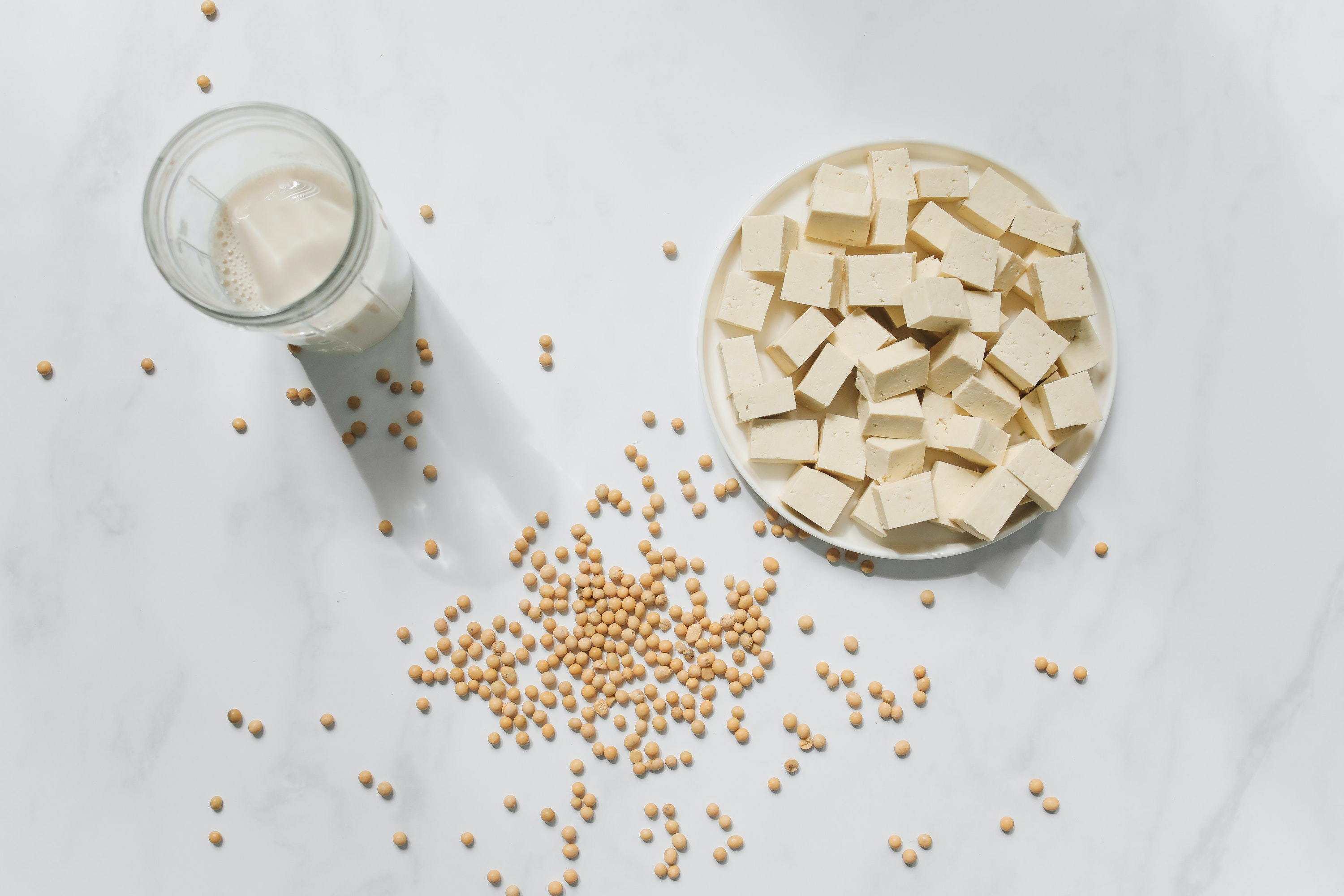As you can likely tell by many of the recipes on my blog, I love my soy foods and tofu! But I wasn’t always like this. At the beginning of my health journey, I remember being terrified of eating soy because of all the crazy things I had heard it could do to hormones. I slowly opened up to a small amount of organic soy after trying some and not noticing anything bad happening, but was terrified of GMO soy. Only to find out that Australia’s soy is not only non-GM, it’s also organic, even the conventionally grown soy is organic although it is not certified. It was then that I realised I was letting my fears dictate my behaviour around soy without much evidence to support my beliefs so I started researching soy for myself. This article hopefully addresses what the evidence says about soy and phytoestrogens. It is surprising to me that soy is one of the most researched foods and yet we still have a lot of confusion over the topic. Personally, I think this is due to the lack of education in how to read and interpret scientific data, and although I am no expert in this area, I don’t think it is right when people make huge, often scary claims based on very low-quality evidence (like case studies and animal/rat based studies that rarely translate into human health) while dismissing the mountain of better quality evidence at our disposal (randomised controlled trials, systematic reviews).
What are phytoestrogens?
Phytoestrogens are compounds belonging to the polyphenol group. They are found in nearly all plant foods in varying amounts. They have a chemical structure similar to estrogen and have been shown to be able to weakly bind to estrogen receptors in the body. There are two main classes of phytoestrogens: isoflavones and lignans. Isoflavanes are the most potent type and are found mainly in soy (this is why so much phytoestrogen research is based on soy) and other legumes like chickpeas and peanuts as well as some fruits. Lignans are found in seeds, whole grains, fruit, and other legumes. There are also some lesser-known phytoestrogens like coumestans and stilbenes found in cruciferous vegetables and a few other plant foods.
Why are phytoestrogens considered a problem for women’s hormones?
Since phytoestrogens have the ability to weakly bind to estrogen receptors, the natural assumption is that they can increase estrogen in the body. Excess estrogen in the body has been identified as a leading cause of breast cancer (1) and other female cancers as well as estrogen dominant conditions like endometriosis, fibroids and PMS. Based on these assumptions, it is easy to see why phytoestrogens would get a bad wrap, however, phytoestrogens are 100 – 1000 times weaker than real estrogen. Phytoestrogens are not the same as the estrogen produced in human and animal bodies. Foods that contain real mammalian estrogen (meat and dairy) which is by and large identical to human estrogen has been shown to lead to excess estrogen in the body (2)(3) and are also linked to resulting diseases such as breast cancer (4) (read my article about dairy here). It should be noted that phytoestrogens from soy and flax have been shown to have the opposite effect and are protective against breast cancer, especially in Asian populations that consume the most soy (5)(6).
What does the evidence actually say about soy phytoestrogens?
Phytoestrogens have both an estrogenic and anti-estrogenic effect, meaning they can raise or lower estrogen in the body as needed. There are two main types of estrogen receptors: alpha and beta. Phytoestrogens have a greater affinity to beta receptors (7). Beta receptors in breast tissue help to mitigate the proliferative (cancer-causing) effects of the alpha receptors, so much so that many of the breast cancer drugs help to upregulate the uptake of estrogen through the beta receptors as opposed to alpha (8). Potentially one of the reasons why soy has been found protective against breast cancer (5). Depending on the target tissue, phytoestrogens have been shown to exhibit different effects which are largely protective and beneficial. For example, phytoestrogens have been shown to help reduce hot flashes in menopausal women (7) by raising estrogen but can also help decrease cyclical breast pain by lowering estrogen (8). Soy has been found to be very beneficial for women with insulin-resistant type PCOS (9). Phytoestrogens can have a protective factor for heart disease and osteoporosis (10).
What about soy and thyroid?
Soy foods have been identified as potential goitrogens, meaning they have the ability to interfere with iodine absorption and therefore upset the thyroid. Soy foods have not been shown to impact the thyroid as previously thought showing no impact on thyroid hormones T3 and T4 and only a very small increase in TSH. Most interactions with thyroid were seen when soy isoflavones are taken as a supplement and not as food sources of soy (11). If taking thyroid medication the recommendation is to consume soy at least one hour before or after medication so as to not interfere with absorption.
Soy and S-equol
Scientists have found a specific compound called S-equol which is produced from the breakdown of soy foods in the microbiome. This compound is responsible for most of the positive health benefits of soy, especially those pertaining to heart and brain health but also for hormone health. 50-70% of Asian populations produce S-equol whereas only 20-30% of the Western population produces S-equol (15). This has been hypothesised as one of the main reasons Western populations see varying and inconsistent health outcomes when consuming soy. For a while, the natural assumption was that the production of S-equol must be genetic and beneficial only for the Asian populations that have the genes to properly digest soy. However, research has confirmed that other non-Asian groups can make comparable or sometimes even higher amounts of s-equol. These groups are “vegetarians” (16). Although the exact mechanisms of why this is are not yet fully understood, we know that simply adding more soy into the diet has varying results on s-equol production. Some people start producing more s-equol while others do not. The findings suggest that S-equol production is likely dependent on the interaction of many microbes within the gut microbiome and that plant-based or vegetarian diets which are naturally more rich in fibre and focused on a diversity of different plant foods are more favourable for S-equol production.
Why do some women get menstrual cycle disturbances with soy?
The side effects of phytoestrogens in the research almost exclusively pertain to women taking isoflavone supplements, not food-based soy. Rarely some women can have an exaggerated response to soy products or flax seeds which have a different type of phytoestrogen (lignans). This generally occurs because gut health is compromised and some women may not have the specific subset of bacteria needed to digest soy or flax. Working on correcting gut dysbiosis can help to correct this problem.
To conclude, soy acts similar to an adaptogen for women’s hormones. It can both raise and lower estrogen as needed. A very large umbrella review on soy concluded that soy is very healthful for overall health with a huge array of benefits for both men and women including breast and prostate cancer prevention, diabetes prevention and management, heart health and bone health (14). Better health outcomes may be seen when soy is combined with a well planned plant-based diet. With so many amazing benefits to soy foods, I do find it hard to understand why they are still so greatly feared. The current recommendation is 2-4 servings of whole soy food products a day for best health outcomes. One serve is equivalent to about 1/2 cup soybeans, edamame, tofu, nato, tempeh (my favourite is Organic Original Tempeh from Primasoy) and 1 cup of soy milk a day. Although we don’t have a tonne of data to suggest that GMO soy is significantly worse for human health, and although most GMO soy is reserved for animal feed and not human consumption in most countries it may still be wise to be mindful and choose organic non-GMO soy products made from whole soybeans and not isolates for best health outcomes, especially in countries that grow GMO crops.
References:
(1)Travis, R. C., & Key, T. J. (2003). Oestrogen exposure and breast cancer risk. Breast cancer research : BCR, 5(5), 239–247. https://doi.org/10.1186/bcr628
(2) Malekinejad, H., & Rezabakhsh, A. (2015). Hormones in Dairy Foods and Their Impact on Public Health – A Narrative Review Article. Iranian journal of public health, 44(6), 742–758.
(3) Harmon, B. E., Morimoto, Y., Beckford, F., Franke, A. A., Stanczyk, F. Z., & Maskarinec, G. (2014). Oestrogen levels in serum and urine of premenopausal women eating low and high amounts of meat. Public health nutrition, 17(9), 2087–2093. https://doi.org/10.1017/S1368980013002553
(4) Lo, J. J., Park, Y. M., Sinha, R., & Sandler, D. P. (2020). Association between meat consumption and risk of breast cancer: Findings from the Sister Study. International journal of cancer, 146(8), 2156–2165. https://doi.org/10.1002/ijc.32547
(5) Messina, M. (2016). Impact of Soy Foods on the Development of Breast Cancer and the Prognosis of Breast Cancer Patients. Complement Med Res, 23(2), 75–80. https://doi.org/10.1159/000444735
(6) Calado, A., Neves, P. M., Santos, T., & Ravasco, P. (2018). The Effect of Flaxseed in Breast Cancer: A Literature Review. Frontiers in nutrition, 5, 4. https://doi.org/10.3389/fnut.2018.00004
(7)Morito, K., Hirose, T., Kinjo, J., Hirakawa, T., Okawa, M., Nohara, T., Ogawa, S., Inoue, S., Muramatsu, M., & Masamune, Y. (2001). Interaction of phytoestrogens with estrogen receptors alpha and beta. Biological & pharmaceutical bulletin, 24(4), 351–356. https://doi.org/10.1248/bpb.24.351
(8) Helguero, L. A., Faulds, M. H., Gustafsson, J.-Å., & Haldosén, L.-A. (2005). Estrogen receptors alfa (ERα) and beta (ERβ) differentially regulate proliferation and apoptosis of the normal murine mammary epithelial cell line HC11. Oncogene, 24(44), 6605–6616. https://doi.org/10.1038/sj.onc.1208807
(9) Barnard, N. D., Kahleova, H., Holtz, D. N., del Aguila, F., Neola, M., Crosby, L. M., & Holubkov, R. (2021). The Women’s Study for the Alleviation of Vasomotor Symptoms (WAVS): a randomized, controlled trial of a plant-based diet and whole soybeans for postmenopausal women. 28(10), 1150–1156. https://doi.org/10.1097/gme.0000000000001812
(10) Vaziri, F., Zamani Lari, M., Samsami Dehaghani, A., Salehi, M., Sadeghpour, H., Akbarzadeh, M., & Zare, N. (2014). Comparing the effects of dietary flaxseed and omega-3 Fatty acids supplement on cyclical mastalgia in Iranian women: a randomized clinical trial. International journal of family medicine, 2014, 174532. https://doi.org/10.1155/2014/174532
(11) Khani, B., Mehrabian, F., Khalesi, E., & Eshraghi, A. (2011). Effect of soy phytoestrogen on metabolic and hormonal disturbance of women with polycystic ovary syndrome. Journal of research in medical sciences : the official journal of Isfahan University of Medical Sciences, 16(3), 297–302.
(12) Al-Anazi, A. F., Qureshi, V. F., Javaid, K., & Qureshi, S. (2011). Preventive effects of phytoestrogens against postmenopausal osteoporosis as compared to the available therapeutic choices: An overview. Journal of natural science, biology, and medicine, 2(2), 154–163. https://doi.org/10.4103/0976-9668.92322
(13) Otun, J., Sahebkar, A., Östlundh, L., Atkin, S. L., & Sathyapalan, T. (2019). Systematic Review and Meta-analysis on the Effect of Soy on Thyroid Function. Sci Rep, 9(1). https://doi.org/10.1038/s41598-019-40647-x
(14) Li, N., Wu, X., Zhuang, W., Xia, L., Chen, Y., Zhao, R., Yi, M., Wan, Q., Du, L., & Zhou, Y. (2020). Soy and Isoflavone Consumption and Multiple Health Outcomes: Umbrella Review of Systematic Reviews and Meta-Analyses of Observational Studies and Randomized Trials in Humans. Molecular nutrition & food research, 64(4), e1900751. https://doi.org/10.1002/mnfr.201900751
(15) Sekikawa, A., Ihara, M., Lopez, O., Kakuta, C., Lopresti, B., Higashiyama, A., Aizenstein, H., Chang, Y. F., Mathis, C., Miyamoto, Y., Kuller, L., & Cui, C. (2019). Effect of S-equol and Soy Isoflavones on Heart and Brain. Current cardiology reviews, 15(2), 114–135. https://doi.org/10.2174/1573403X15666181205104717
(16) Setchell, K. D., & Cole, S. J. (2006). Method of defining equol-producer status and its frequency among vegetarians. The Journal of nutrition, 136(8), 2188–2193. https://doi.org/10.1093/jn/136.8.2188











These studies are mostly in Asian populations who generally have S-equol in the bodies and are able to process soy differently from Blacks, Hispanics, whites and other populations.
Asians and menopausal women are the only people who should eat soy regularly. Everyone else should avoid it.
Thank you, I have gone through and addressed the S-equol conversation in the article. I have been watching it for a while and thanks to the research on the microbiome I think it has made sense to me. I agree we need much more research on women of reproductive years in general but this is slowly changing.